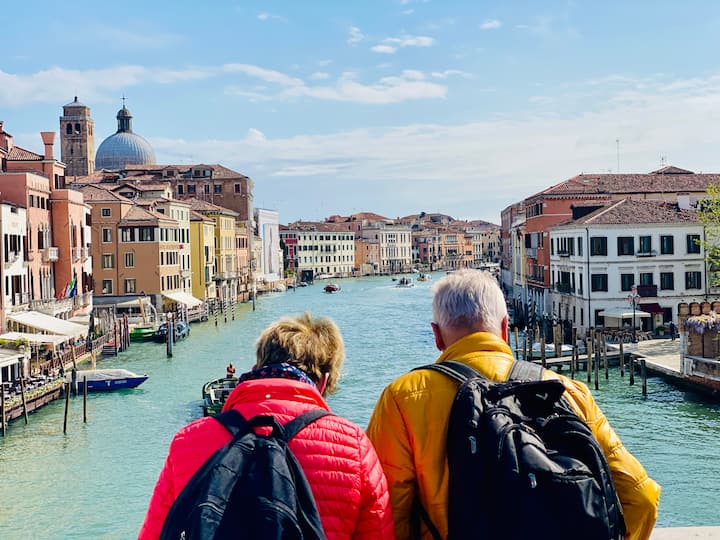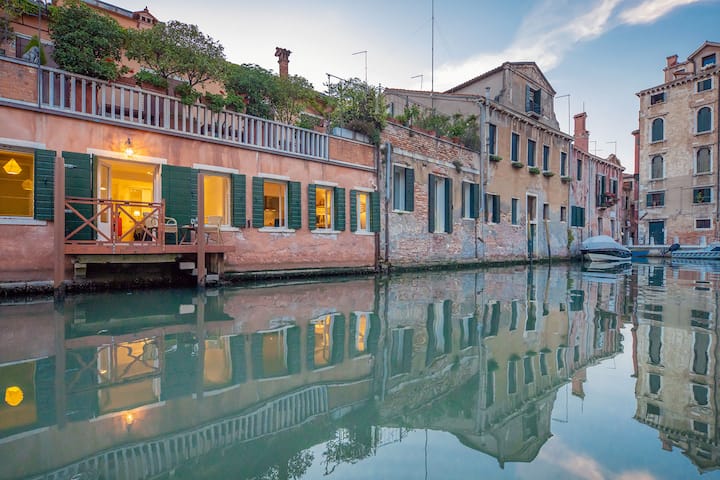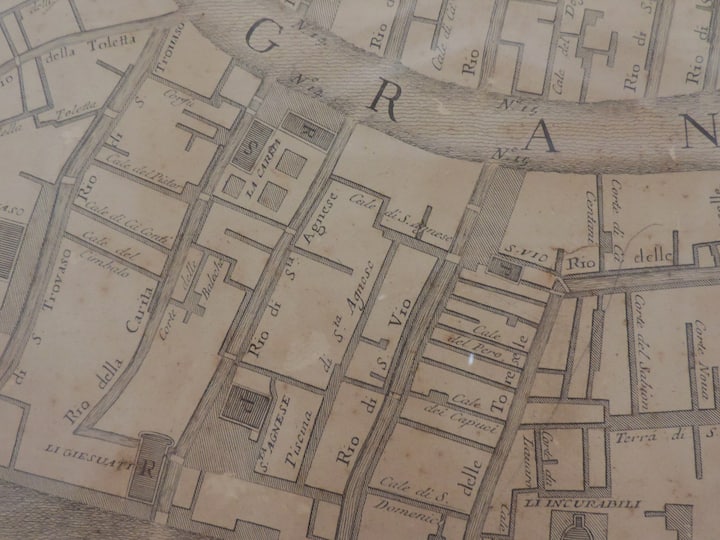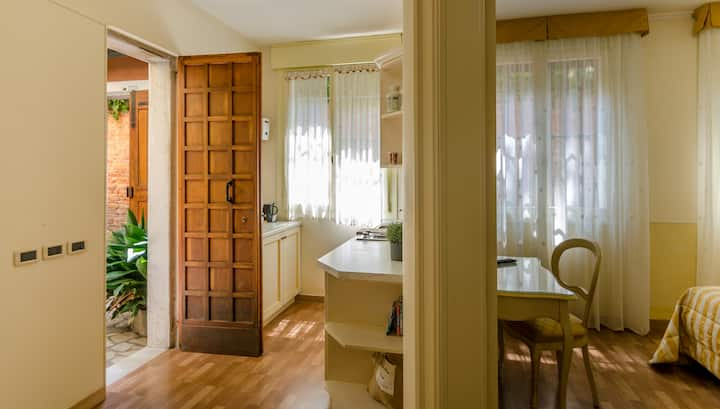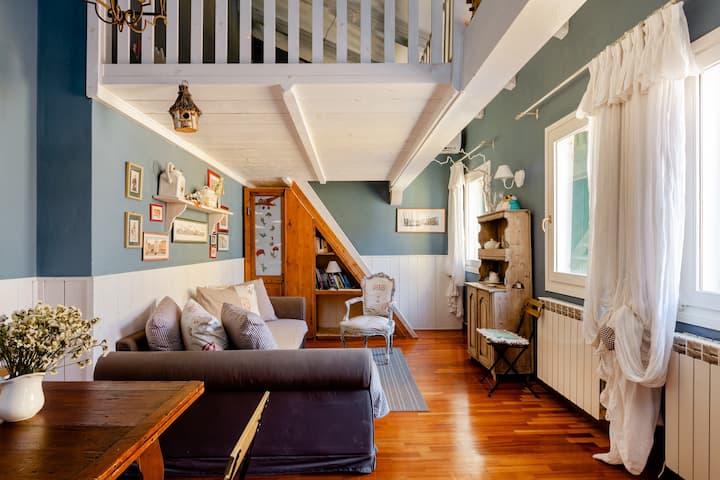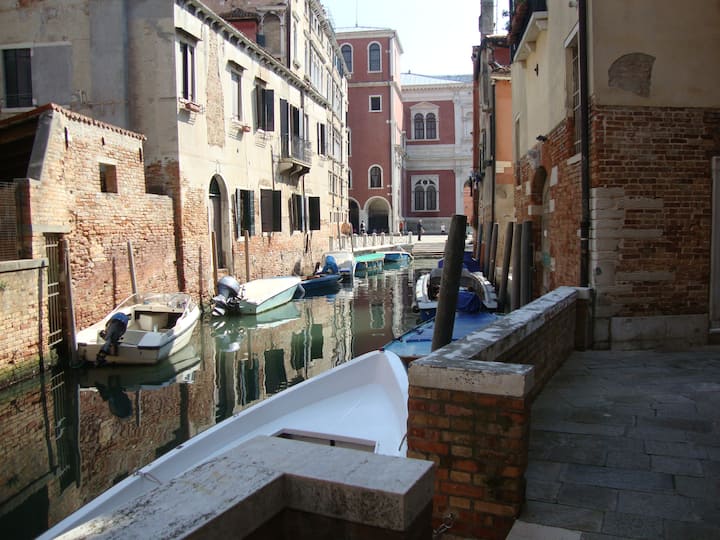Nachbarschaft
Santa Croce
Von 18 Einheimischen empfohlen,
Standort
Venice, Veneto
Santa Croce
Tipps von Einheimischen
While every corner in Venice is about art and history, just a stone's throw from your stay Palazzo Mocenigo and Ca'pesaro are mustsee museums to see with exhibitions from medieval textile to contemporary paintings to oriental exhibits. Campo San Giacomo is a lovely squire with its popular tango evenings and everyone's favourite trattoria La Zucca just across the bridge. Frari church, the second largest in the city, with the famous Venitian art schools Scuola Grande di San Rocco and San Giovanni Evangelista are again mustsee places to get acquainted once you are in the area, In the evening, Il Mercante, next historical place in front of the Frari church, but this time to enjoy spritz or other varieties of cocktails in a stylish and friendly atmosphere.
While every corner in Venice is about art and history, just a stone's throw from your stay Palazzo Mocenigo and Ca'pesaro are mustsee museums to see with exhibitions from medieval textile to contemporary paintings to oriental exhibits. Campo San Giacomo is a lovely squire with its popular tango even…
Per sfruttare al meglio i 2 giorni a Venezia (che avete a disposizione) occorre organizzarvi prima di partire e quindi (senza spremervi troppo le meningi) affidatevi a noi e vi guideremo in un itinerario di due giorni a Venezia alla scoperta delle cose da fare assolutamente.
Santa Croce è il più piccolo quartiere della città ma perdersi all'interno dei suoi stetti vicoli è affascinante e caratteristico. Il cuore di Santa Croce è campo San Giacomo dell'Orio. A due passi si trova lo splendido museo di Storia Naturale all'interno di quello che fu il Fondaco dei Turchi ai tempi della Repubblica Serenissima di Venezia.
ITALIANO È il più piccolo dei Sestieri di Venezia ed è la “porta d’ingresso” per chi arriva dalla terraferma. È l’unico Sestiere ad avere una zona (Piazzale Roma), seppur limitata, in cui è permesso alle vetture di circolare. Prende il nome dall'antichissima Chiesa di Santa Croce, il cui impianto originale risaliva al VII secolo e fu demolita nella prima metà del IX secolo dopo le soppressioni Napoleoniche. Della Chiesa rimane solo una colonna, attualmente incorporata nel muro che circonda i Giardini Papadopoli. I Giardini sono l’unica area verde rimasta per una intensiva attività di edilizia popolare dopo la costruzione della Stazione Ferroviaria di Santa Lucia. Il Sestiere Santa Croce in origine occupava un’area periferica della Città (Venezia si poteva raggiungere solo in barca, approdando alla Fondamenta delle Zattere nel Sestiere di Dorsoduro), scarsamente popolato ed era una zona puramente di paludi e saline chiamata “Luprio”, perché forse infestata da Lupi. Successivamente venne bonificata per la coltivazione di Orti e Vigne. Il suo sviluppo cominciò dalla metà del XIX secolo con la costruzione del Ponte Ferroviario prima e nel 1933 con la costruzione del “Ponte Littorio” (Ponte della Libertà) durante il Regime Fascista. È il Sestiere che più di qualsiasi altro nel XX secolo ha subito l’impatto da questi collegamenti, prima con la realizzazione della Stazione Marittima e in successione con la creazione dell'area di Piazzale Roma, l'apertura del Rio Novo e la costruzione del parcheggio-isola artificiale del Tronchetto, che hanno trasformato la parte nord del sestiere nel terminal automobilistico e dei bus nella città lagunare. Il Sestiere è caratterizzato da Calli strette intervallate da pochi Campi ed è l’unico sestiere di Venezia ad unire l’antico, il moderno e il contemporaneo. Non è ricco di attrazioni e monumenti, ma non per questo meno interessante artisticamente e architettonicamente. Cosa vedere: - People Mover (sistema di trasporto che collega l’Isola del Tronchetto a Piazzale Roma) - Cittadella della Giustizia - Ex Chiesa di Sant’Andrea della Zirada - Ponte della Costituzione - Chiesa di San Simeon Piccolo - Ponte degli Scalzi - Chiesa di San Simeon Grando - Fontego dei Turchi (Museo di Storia Naturale) - Chiesa di San Zan Degolà (Chiesa di San Giovanni Battista Decollato) - Chiesa di San Giacomo dell’Orio - Fontego del Mégio - Palazzo Belloni Battagia - Chiesa di San Stae - Palazzo Ca’ Pesaro (Museo d’Arte Orientale e Galleria Internazionale d’Arte Moderna) - Museo di Palazzo Mocenigo (Museo del Tessuto, del Costume e del Profumo) - Palazzo Ca’ Corner della Regina (sede della Fondazione Prada) - Chiesa di San Nicola di Tolentino - Calle Ca’ Zusto (larga 65cm) - Chiesa di San Cassian - Chiesa di Santa Maria Mater Domini ENGLISH It is the smallest of the Venice Sestieri and is the "gateway" for those arriving from the mainland. It is the only Sestiere to have an area (Piazzale Roma), albeit limited, in which cars are allowed to circulate. It takes its name from the ancient Church of Santa Croce, whose original structure dates back to the 7th century and was demolished in the first half of the 9th century after the Napoleonic suppressions. Of the Church only a column remains, currently incorporated into the wall that surrounds the Papadopoli Gardens. The Gardens are the only green area left for intensive public housing activity after the construction of the Santa Lucia railway station. The Sestiere Santa Croce originally occupied a peripheral area of the city (Venice could only be reached by boat, landing at the Fondamenta delle Zattere in the Dorsoduro district), sparsely populated and was an area purely of marshes and salt marshes called "Luprio", because possibly haunted by wolves. Later it was reclaimed for the cultivation of Orti and Vigne. Its development began in the mid-nineteenth century with the construction of the Railway Bridge first and in 1933 with the construction of the "Ponte Littorio" (Ponte della Libertà) during the Fascist regime. It is the Sestiere that more than any other in the twentieth century suffered the impact of these connections, first with the construction of the Maritime Station and subsequently with the creation of the Piazzale Roma area, the opening of the Rio Novo and the construction of the Tronchetto artificial parking-island, which transformed the northern part of the district into the car and bus terminal in the lagoon city. The Sestiere is characterized by narrow calli interspersed with a few fields and is the only district in Venice to combine the ancient, the modern and the contemporary. It is not rich in attractions and monuments, but no less interesting artistically and architecturally. What see: - People Mover (transport system that connects Tronchetto Island to Piazzale Roma) - Citadel of Justice - Former Church of Sant’Andrea della Zirada - Constitution Bridge - Church of San Simeon Piccolo - Ponte degli Scalzi - Church of San Simeon Grando - Fontego dei Turchi (Natural History Museum) - Church of San Zan Degolà (Church of San Giovanni Battista Decollato) - Church of San Giacomo dell’Orio - Fontego del Mégio - Palazzo Belloni Battagia - Church of San Stae - Palazzo Ca' Pesaro (Museum of Oriental Art and International Gallery of Modern Art) - Museum of Palazzo Mocenigo (Museum of Fabric, Costume and Perfume) - Palazzo Ca' Corner della Regina (headquarters of the Prada Foundation) - Church of San Nicola di Tolentino - Calle Ca' Zusto (65cm wide) - Church of San Cassian - Church of Santa Maria Mater Domini
ITALIANO È il più piccolo dei Sestieri di Venezia ed è la “porta d’ingresso” per chi arriva dalla terraferma. È l’unico Sestiere ad avere una zona (Piazzale Roma), seppur limitata, in cui è permesso alle vetture di circolare. Prende il nome dall'antichissima Chiesa di Santa Croce, il cui impianto or…





